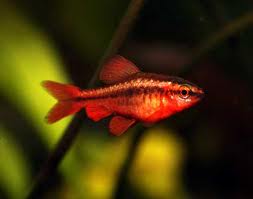
Common name: Cherry Barb
Scientific name: Puntius Titteya
Average Adult Fish Size: 2 inches / 5 cm
Place of Origin: Tropical waters in Sri Lanka, from Kelani to the Nilwala basin.
Typical Tank setup: A well planted aquarium with rockwork, bogwood/driftwood. In order for Cherry Barbs to show off their best coloration they need hiding places, such as plants, to feel secure.
Recommended Minimum Aquarium Capacity: 10 gallon / 40 litre
Compatibility: They are a peaceful fish that should be kept with other peaceful fish of similar size. Larger fish may consider them as a source of food. They should be kept in schools of 5 or more. Do not keep them with the larger and more aggressive Tiger Barb.
Temperature: 73 – 80.5 Deg F / 23 – 27 Deg C
Water chemistry: pH 6.0 – 8.0
Feeding: Omnivorous and do well on a varied diet of micro pellets, flakes, frozen and live brine shrimp, as well as microworms, blood worms, and daphnia.
Sexing: Sexing Cherry Barbs are not difficult since the male feature a vivid, cherry-red colouration. Female Cherry Barbs are not as vividly colored and will usually display a rather dull orange shade. Both males and females display a dark horizontal stripe along their body, but the stripe will be much more noticeable on the female fish since she is paler. You can also notice a difference in body shape between the two sexes. Males are generally more slender while the females tend to have fuller bodies. The male Cherry Barb is also larger than the female.
Breeding: Wild Cherry Barbs produce around 200 eggs that are scattered among plants. After one or two days, the offspring will hatch. After two more days, the offspring are free-swimming.
Cherry Barbs will readily spawn in captivity and a lot of the specimens in the aquarium trade are captive bred. During the spawning period, the male Cherry Barb will become even more vividly colored than normally. Cherry Barbs are egg scatterers and if the eggs are left in the aquarium, the adult fish will most likely eat a good portion of them. Professional Cherry Barb breeders will therefore usually arrange a separate breeding tank where the offspring can develop without the presence of adult fish.
If you do not want to set up a separate breeding tank, you can increase the chance of fry survival by keeping the aquarium well planted. Choose plant species that provide a lot of hiding spaces, such as Java moss. The female Cherry Barb will release her eggs among the plants and the offspring will instinctively hide among the plants until the young Cherry Barbs are large enough to fend for themselves.
Additional Information: The average Cherry Barb life span is 4 years, but they can live 7 years or more. They make a fantastic addition to a community aquarium with tetras.


Related Posts
Croaking Gourami – Trichopsis vittatus
Benthochromis Tricoti
Large-eyed Mouthbrooder – Callochromis Macrops